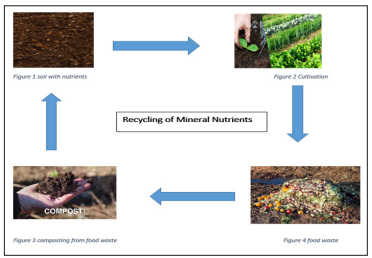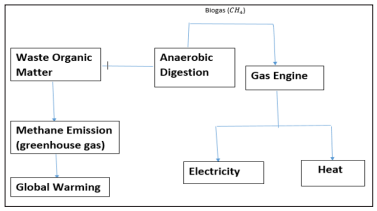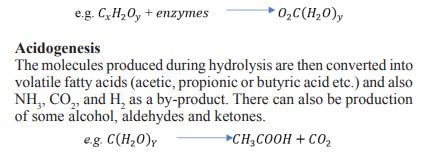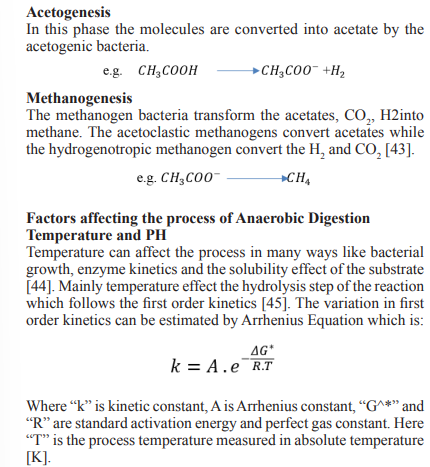Author(s): Parveen Parihar* and Rakesh Choudhary
Presented study is about the management of food waste which is today’s one of the major issue all around the world. The improper management process makes food waste more problematic as it creates various environment pollutions and harm human health. The two methods for better management are discussed in detail which is sustainable because these are eco-friendly, cost effective and harmless to human. These methods are anaerobic digestion and composting. In both methods the decomposition of organic waste is done by the microorganism. In anaerobic digestion it is done in the absence of oxygen while in composting oxygen is necessary for the degradation process. The product obtain from anaerobic digestion is the biogas which is used as fuel and digestate which is used as bio fertilizer. From compost we get compost as product that is a natural fertilizer. So, both the methods have advantages without any harm. Various factors which affect these methods are also discussed. Both the method discussed are the way of recycling and reuse of food waste which is commonly organic in nature and can be decomposed by microorganism and give value added end product.
Out of the food produced globally its one third part is wasted or lost [1]. Recycling- renewable-reuse process is today’s one of the necessity for world because of the limited availability of natural resources. There are several processes for recycling which can be natural or can be held by human. The most important need for human to survive is food. But consuming food also create a large amount of waste which can be non- edible waste or the left overs. These wastes are mostly of the organic degradable composition. If we put these waste for land filling this can be deteriorate for the environment. But proper management of this waste can make it renewable and reuse. The valorization of these waste materials is done by the biological degradation process. Mainly two process can be used for this which are- composting and anaerobic digestion. Both are effective in proper management of the waste food [2]. These managing processes are efficiently environment friendly also in many aspects. The main reason is these process reduce the greenhouse gases emissions and also improve the properties of soil [3]. The product obtain from composting is the compost and from anaerobic digestion it is the digestate and the biogas which is mainly CH4 and CO2. These products obtain can be used as the natural fertilizers and for the soil remediation.
The total waste generation per year all over the world is expected to be 27 billion tones by the year 2050. Presently Asia produces the one-third of the total waste, with notable contribution of China and India. In India about 143,449 MT of municipal solid waste is generated daily, out of which only about 35,602 MT are treated [4]. The recycling process of waste has not been done proper as prescribed. The improper management of waste causes various health issues and can even be reason of death [5].
The main reason for the management of waste food is the environment concern. Because of the waste food environment is the most effective one. By putting the waste food for land filling or incineration raise different types of environment pollutions. By land filling and incineration there will be long term presence of toxic elements on land and by the improper degradation there is emission of greenhouse gases like- CO2, N2O, CH4 and O3 etc. and liquid emission (leachate) [6]. In this sense the food waste contributes to the global warming impacts. While proper management by replacing land filling with the composting or anaerobic digestion mitigate the global warming impacts [7]. Another contribution of food waste for the environment pollution is the acidification, particulate matter and formation of photochemical ozone. This is due to the emission of NOx and volatile organic compounds [5]. Because of the landfill of food waste there is also aquatic eutrophication. All these problems can be resolved by proper management like composting and anaerobic digestion which makes the waste reusable without any hazardous effect [8].
There are many methods available for the processing of food waste. The most commonly used method is the land filling which isused worldwide [9]. This method of waste management is harmful for the environment and the human as well. It is not beneficial in any aspect. Because of land filling there is production of leachate which pollute the soil and groundwater as well by adding toxic metals and other harmful organic compounds [10]. By practicing land filling the natural resources are effected the most [11]. Another process used for food waste management is the incineration. In this method the volume of food waste is reduced and then landfill It is costly as it requires technical instruments for the control on gaseous emission. So, this method is not very useful in developing countries [12].
The management of food waste should be sustainable in environmental, economic and social form. The recycling of food waste can play an important role in controlling the greenhouse gas emission and other environmental pollutions [13]. For proper management it is necessary to categorize the food waste. It could be categorizing according to the nutrient composition like- fat, carbohydrate content etc. [14]. It could also be categorizing regarding chemical composition like- C, N, O contents etc. [15]. The figure no.1 below showed the processing of food waste management.

Figure: Food waste processing
The sustainable methods for food waste management are discussed below:
It is an organic degradation process of food waste which is aerobic in nature. It requires oxygen for the microbial decomposition of organic matter. The product obtain from this is called ‘compost’. Compost is used as fertilizer or soil amendment which is environmental friendly, harmless to human and also economic beneficial [16].
The product of composting ‘compost’ is the better alternative for the chemically synthesized fertilizer. Compost improves the soil fertility and also the plant yield [17]. Because of the soil erosion soil lost its fertility. Because erosion leads to the loss of nitrogen, phosphorus, potassium like nutrients. Compost can successfully fight with erosion. It increases the water holding capacity of soil, structure of soil and stability of soil [18]. This property of compost is due the humus which bind the soil and hold soil constituent together [19].
The microorganisms present in compost are capable of fighting with the pathogens present in soil. They can compete with pathogen for nutrients, extra cellular enzymes or compounds. The practice of doing incineration of waste material leads to pollution and is a waste of time. Land filling is also not a good option for treating the waste because it also harms the land. Ultimately both practices are responsible for the waste of resources. On other hand doing composting or controlled biological degradation of waste organic matter is a better sustainable option because of reasons like- it is lower in cost, it decrease the environment pollution, less water pollution and the end product obtained is beneficial as organic fertilizer [20].
All the mineral nutrients are obtained from the land or from farmland. Regular consumption of these mineral nutrients creates its deficiency. But composting is a process by which we can do recycling and reuse of mineral nutrients [21]. Plants absorb all the nutrients from the soil that are necessary for their growth. And other living beings consume the nutrients from plants. In this way there will be regular reductions of mineral nutrients in soil. By composting we can again deliver the nutrients to soil and can maintain its good health. The whole process is recycling and reuse of mineral nutrients [22]. Figure no. 2 below showing the recycling of minerals.

Figure: showing nutrients recycling by composting
With the continuous use of chemical fertilizers soil losses its biological and physical properties which directly affect the growth of a plant. Research shows that the use of compost instead of chemical fertilizer improves the plant growth. By using compost, the number of flowers are increased and also the plant carotenoid content increase [23]. There is a significant effect of compost on growth of a plant. Plant shows better height, more leaves, more flowers and better root shoot ratio because of the use compost [24].
The economic feasibility of composting depends on the quality of compost. The selling of compost in market is more profitable if its quality is good. To get good quality of compost which can be sell on higher prices is related to the type of organic waste used as input in composting. The other investment in this process is the type of method and use of land [25].
Compost works as a sponge in soil which increase the porosity of clay soil, because of this it does not dry out easily or waterlogged [26]. So, compost is a suitable natural fertilizer which can overcome the climate changes and reduce the water shortage problem for farmers in dry regions also control soil erosion and desertification [27].

Here the reaction is showing the chemical mechanism of composting process.
It is necessary to maintain a thermophilic temperature range to get a good quality of compost. When the process of composting is done in reactors the temperature can be control by the aeration rate or the type of organic waste etc. if the process is completed in windrow then the temperature is controlled by the amount and type of organic waste only [28]. Temperature is one of the major factor that influence composting. It affects the rate of process as well as kills the harmful pathogen during the process that means temperature maintain the sanitation during the process. Generally maximum degradation of organic matter is completed in thermophilic temperature range (55-60°C) [29].
Adding Caco 3 , PO4 -3 or both in the process of composting increases the pH of system. When both Caco 3 , PO4 -3are added there is no effect on the degradation of organic matter but if these are added individually then they can increase the degradation process [28].
Moisture content is also a significant factor that affects the process of composting. It effects the physical, chemical and biological properties of composting [30]. Bulking agents are used in the process to control the moisture content. Added bulking agent absorb the excess moisture content [31].
Bulk density determines the favourable condition for the microbial growth, degradation process and activity of microorganisms during the composting process [32]. It is also an important factor for the mechanical properties of the process [33]. On adding bulking agent in composting pile, it affects bulk density of compost. By adding bulking agent there is a decrease in bulk density of final product compost [34].
The degradation process in composting is also affected by the PH range of the system. The optimal PH range required for composting should be 7 or neutral [33]. Studies shows that the range of PH between 7-8 in composting system indicate the microbial degradation of organic matter [34]. During composting the PH is increased in starting and become constant at the end because of the stabilized product obtain. This increase in PH is due to the proteolytic bacterial activity. For the buffering of system bulking agents can be used which don’t allow the further change in PH [35].
This is an anaerobic degradation of food waste in which the anaerobic microbial community decompose the waste in absence of oxygen. There is production of biogas and digestate from this process. The biogas produce is used as a fuel and the digestate is used for soil. It is an economically effective way of food waste management [36].
By using the non-renewable methods for the production of energy put a negative impact on environment. Energy can also be produce by renewable methods like from wind, water, sun, biomass etc. these renewable methods are more sustainable because these are eco-friendly methods and also improve the environment. The production of biogas from biomass is one of the renewable methods which can be used as a fossil fuel. Its sustainability is due to the fact that the production of biogas is completely natural, renewable and very low in cost [37]. The process of biogas production from food waste by anaerobic digestion is represented in the figure 3.

Figure: showing biogas production
Methane is one of the greenhouse gases whose global warming potential is about 28-36 times higher than the CO 2 . The emission of CH4 occurs due to storage or digestion of biomass. The proper management of anaerobic digestion produces biogas which can be reuse and it minimize the direct emission of CH4 as a greenhouse gas [38].
As comparing with other food waste technologies like incineration, landfill or composting there is no any significant effect of anaerobic digestion on the environment. The main reason for environment concern is the aquatic toxicity, eutrophication and the global warming. But the process of acidogenesis during anaerobic digestion reduces the pollutions [39].
There are some stepwise chain reactions which take place during the process of anaerobic digestion [40]. These steps are as follow:
The process start with the degradation of macro polymer molecules like carbohydrates, lipids and proteins of the substrate which are hydrolysed into small soluble molecules like sugar, amino acids and long chain fatty acids. This is called hydrolysis and is an extracellular reaction. It is carried out by the bacterial enzymes by the adsorption of enzyme on the surface of substrate molecule [41,42].


Redox Conditions For the degradation of organic matter there is need of electron acceptor. In anaerobic digestion CO2 works as electron acceptor. Because of the transfer of electron from one compound to another some amount of energy is released due to the redox process. The energy released is useful for the growth and maintenance of the microorganisms [44].
The total waste material used in anaerobic digestion effect the whole process. If there is change in waste material, then it leads to change in the morphology of microorganism working in the system. The performance of anaerobic digestion is better when there is reduction of volatile solid material and the production of biogas increase by increasing the total waste material [46].
The process of anaerobic digestion is a biodegradation proceed by microorganism. Different types of microorganism communities play different role in the system. If the waste material used in anaerobic digestion is pre-treated with microbial community BYND-5 then the biogas production is increased by 20% [47]. The biological pre-treatment with microbial consortia degrade the lignocelluloses into volatile fatty acids. The microbial community methanosaeta enhance the methanogenesis process by capturing the acetic acid. Overall the microbial consortium significantly affect the anaerobic digestion and the production of biogas [48].
Both the methods are useful for proper management of food waste in their own way. The two methods have some similarities and dissimilarities from each other. In each process the degradation of organic matter take place and the products obtain from both are useful. It. From the economic point of view anaerobic digestion is costlier than composting but the yield biogas and fertilizer can earn cost. Studies suggested that composting is cheaper and economical profitable than anaerobic digestion. The environmental benefit of both is not comparable as the choice of method can be done on the basis of available space or the utility of generated biogas. It is also estimated that from anaerobic digestion the reduction of greenhouse gases emission is about 35.22% more than that of composting [49]. The mixing of both the process is also a good idea. If the digestate from anaerobic digestion is further used for composting, then the end product obtain will be of much better quality [50]. Both the process is effective on reducing the greenhouse gas emission and reducing the organic waste going to landfill [51].
There are several methods used for the management of food waste. But methods like landfilling and incineration which are most commonly used methods have their harmful effects. They damage the natural resources and also put bad impact on human health. Management of food waste should be in such a way that it should not put any negative impact. The method should be sustainable so that can be used for long duration without any harm. The two better and sustainable methods discussed in this paper are the composting and anaerobic digestion. Both the methods have their advantages which make sure their sustainability. These methods are based on recycling-reuse trend. There are several factors which affect the process and the rate of mechanism in both anaerobic digestion and composting. The proper management of food waste by these methods can lead recycling of the food waste which is generally thrown out in trash and create problematic issues for environment and the human. Proper management can make it reusable, environment-friendly and economically beneficial. More research and studies on food waste management by composting and anaerobic digestion can make them more feasible and general way for the management of food waste.
Acknowledgement: Not available
